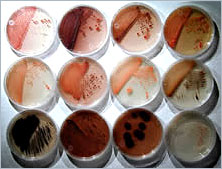Marine bugs make drugs
Marine actinomycetes, the sea-going counterparts of soil-dwelling microbes, make some highly biologically active substances. A US team has recently discovered a new antitumor agent in one of these marine bacteria and by exploiting X-ray diffraction and spectroscopy have determined its precise structure, offering a new target for synthetic chemists to focus on.
Actinomycetes, soil bacteria with fungal-like filaments, have long been tapped by pharmaceutical researchers as a source of novel antibiotics, actinomycin and streptomycin for instance. Now, William Fenical {{http://fenical.ucsd.edu/}} of the Scripps Institution in La Jolla and his colleagues have discovered a new source of potential drugs - actinomycete living in tropical and subtropical ocean sediments. Like their soil-dwelling cousins, the marine actinomycetes produce highly active substances. Fenical's team has examined one particular candidate, which might lead to a novel anticancer drug.
 The compound salinosporamide A was sourced from the Salinospora species of marine actinomycetes and has a central ring system consisting of a four- and a five-membered ring. The ring system is common to this compound and omuralide, the first specific proteasome inhibitor. The proteasome is a cellular "garbage removal" system that fragments and removes unwanted proteins from within the cell. Without it the cell would quickly die. This is particularly true of rapidly growing tumor cells and so pharmaceutical researchers hope a proteasome inhibitor will make a potent anticancer drug.
The compound salinosporamide A was sourced from the Salinospora species of marine actinomycetes and has a central ring system consisting of a four- and a five-membered ring. The ring system is common to this compound and omuralide, the first specific proteasome inhibitor. The proteasome is a cellular "garbage removal" system that fragments and removes unwanted proteins from within the cell. Without it the cell would quickly die. This is particularly true of rapidly growing tumor cells and so pharmaceutical researchers hope a proteasome inhibitor will make a potent anticancer drug.
Salinosporamide A turns out to be 35 times as strong a selective inhibitor of the proteasome as omuralide itself, the Fenical team has found. "In initial trials on cell cultures, salinosporamide A demonstrated strong and selective cytotoxic activity against various lines of cancer cells," says Fenical.
Angew. Chem. Int. Ed. 2003, 42 (3), 355-357; http://dx.doi.org/10.1002/anie.200390115

